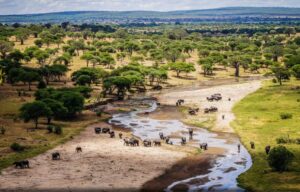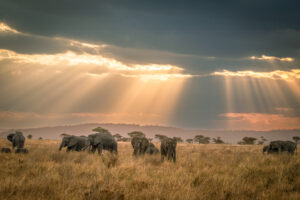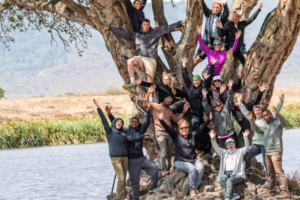
THE HISTORY OF TANZANIA
Sitting midway between the Serengeti and Ngorongoro Crater, Olduvai Gorge has been called “The Cradle of Mankind.” Prehistoric fossils of hominid remains discovered at the
The term “Big 5” was originally coined in the 19th Century by big game hunters who found these large African mammal species a trophy to bring home because they were dangerous and difficult to hunt. Going on safari with Wanderful Tanzania allows modern safari enthusiasts to hunt for the Big 5 too, but the only shooting we do is with cameras. When you book travels with Wanderful Tanzania you’ll set out on an adventure to catch sight of and photograph the African elephant, Cape buffalo, African lion, leopard, and rhinoceros.
There have been conservation efforts to save the Big 5 and they are protected in national parks and private game reserves. Being able to see these species living wild and free in their natural habitats is one of the most unforgettable thrills a traveler can have on safari. To prepare you for your trip, here is information about each of these amazing creatures.
African elephant
African elephants are the world’s largest land animals and can be between 8 to 13 feet tall and weigh in at more than 22,000 pounds (10 tons). Adult males, called bull elephants, are usually solitary creatures but they can also be seen in bachelor groups. Herds of females are very social and typically travel together led by a matriarch and surrounded by younger females and their offspring.
They eat up to 375 pounds of vegetation and drink 50 gallons of water every day. Their plant-based diet includes grass, leaves, bushes and the bark from trees.
While many people will call these creatures “gentle giants,” African elephants are more likely to charge than the other Big 5 species. This is especially true if they feel threatened in any way or the view of their young is blocked.
Poaching is still a major issue and thus, the African elephant is listed as Vulnerable on the International Union for Conservation of Nature (IUCN) Red List of Threatened Species. In Tanzania, African elephants (and rhinos) are on the rebound due to government crackdowns on poachers. It now has one of Africa’s most significant remaining elephant populations, the only population that is larger is in Botswana.
Cape buffalo
The Cape buffalo is the most common subspecies of African buffalo. Males can weigh up to 2,000 pounds. They are mostly found in groups and large herds, and have a complex social structure.
Of all the Big 5, the Cape buffalo is perhaps the most dangerous to humans because they are very protective and territorial. When they are threatened they are known to charge with a surprising speed of 35 miles per hour.
While their movements can be unpredictable, experts say that when the herd rests, females sit on the ground facing the direction they think the herd should move next. When they rise, there is a bit of a silent “vote” because they only progress along the route that the majority of them are facing.
Calves are only born during the rainy season when there is more food and water for survival. So if you see a calf in the group, you know it’s young because calves stay with their mothers for about one year before becoming more independent; males leave the herd at approximately two years old.
If a Cape buffalo is on the ground and you can’t see its genitalia, you can tell a male from female by looking at the horns. Male horns come together and fuse on the forehead. This is known as a “boss.” The thicker and larger the horns usually indicates that the male is ranked higher in the dominance hierarchy of the herd.
Despite their size and fierceness, the buffalo has a primary predator: the lion. But in return, the Cape buffalo are capable of defending themselves and have been known to chase and kill lions that have harmed another member of the buffalo group.
African leopard
The African leopard is the most elusive of the Big 5 animals. In addition to being superbly camouflaged and loners, they are nocturnal and spend the daylight hours hidden from view.
When looking for them on safari, be sure to scan the trees. They are excellent climbers and use this ability to store fresh kills away from lions and hyena. In addition to a carnivorous diet of antelope, gazelles, deer and monkeys, they’ll eat pretty much anything that moves including bugs, birds, fish, snakes, and rodents.
If they’ve got their eye on something, it’s likely they will catch it due to their speed (36 mph) and ability to jump as high as 20 feet horizontally and 10 feet vertically. They are also very strong swimmers.
Leopards are currently threatened by humans and are listed as Vulnerable on the IUCN Red List.
African lion
When it comes to safari royalty, the African lion is the king of the sub-Saharan savannah. You can find them in prides of 12 to 30 that include both males and females. The males are easily distinguished from females by their shaggy manes and the darker the mane, the older the lion.
Even though the males are generally much larger, the females do most of the hunting. Their prey includes wildebeest, impalas, zebras, impalas, and giraffes. Because they typically hunt at night, during daytime safaris, you’re more likely to see these giant cats sleeping in the shade. Like a house cat that sleeps all day, African lions can sleep for up to 20 hours a day.
If it’s a stormy night during your safari, you can be sure the lions are out. Hunting while it is dark and noisy gives them an advantage over their prey because the lions become harder to see and hear. And if you hear a lion’s roar, it doesn’t necessarily mean it is near. A roar can be heard from 5 miles away.
Rhinoceros
There are two types of rhinos in Africa: black and white. A white rhino is not named because of its color, instead it comes from a Dutch word, “weid.” The term means wide and refers to the species broad, wide mouth. In comparison, the black rhino has a more pointed mouth. And while they mainly eat grass and leaves, these are giant creatures that can weigh up to 3 tons.
White rhinos are much larger than the black rhinos. They are also more common. However, if you are able to see one on safari, consider it a special treat because rhinoceros are, unfortunately, an endangered species. There are approximately 27,000 rhinos in the world that remain in the wild.
The rhino’s hearing and sense of smell are excellent and likely make up for the fact that they have such poor vision they sometimes attack trees and rocks believing them to be predators.
Nothing like the wild
If you’ve only ever seen the Big 5 in a zoo setting, you will be amazed when you see these creatures in the wild. And while we’re living in a changing world where these animals and their habitat are threatened by poachers and climate change, taking the opportunity to book your safari and see these animals now is an experience you will not forget. Find an upcoming safari.
Share:

Sitting midway between the Serengeti and Ngorongoro Crater, Olduvai Gorge has been called “The Cradle of Mankind.” Prehistoric fossils of hominid remains discovered at the

I’m frequently asked, “What’s the best time of year to go on a safari in Tanzania?” My initial responses are typically rather cheeky, alternating between,

1. We Commit To Our Expertise And Focus On Tanzania In short, we are all about TANZANIA, 100% of the time… after all, it’s even

Wanderful Tanzania is an African Safari Tour Company partnership powered by Periquito Adventures & Travel in the USA.
© Copyright 2023 | Wanderful Tanzania | All Rights Reserved | Powered by Periquito Adventures & Travel